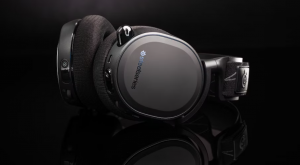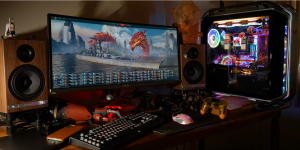Redefine Precision: Gaming Monitors That Give You the Edge
4 min read
Introduction
Gaming has evolved from a casual pastime to a highly competitive and immersive experience. As gamers seek every possible advantage, one crucial element stands out—the gaming monitor. Precision and the edge they provide can make all the difference between victory and defeat. In this article, we will delve into the world of gaming monitors, exploring their essential features and understanding how they redefine precision for gamers.
Understanding Gaming Monitors
Gaming monitors differ significantly from regular monitors. Designed to enhance gaming experiences, they prioritize performance over other aspects. The most critical factors are refresh rates and response times, which play a pivotal role in providing smooth and seamless gameplay.
Key Features to Look for in Gaming Monitors
When choosing a gaming monitor, several features must be considered. High resolution and pixel density are essential for crystal-clear visuals, while adaptive sync technologies like G-Sync and FreeSync prevent screen tearing during fast-paced action. Additionally, understanding different panel types (IPS, TN, VA) will help gamers make informed decisions about their preferences.
Refresh Rates: The Smoothness Factor
Refresh rates refer to how many times a monitor updates its display per second. The higher the refresh rate, the smoother the visuals during gameplay. For competitive gaming, high refresh rates like 144Hz or 240Hz are favored, as they provide a significant advantage in reaction time and motion clarity.
Response Times: Eliminating Ghosting
Response time measures how quickly a pixel can change from one color to another. Slow response times lead to motion blur and ghosting, affecting the overall gaming experience. Low response times, particularly 1ms, are sought after by gamers who engage in fast-paced action.
Input Lag: The Ultimate Responsiveness
Input lag is the time taken from pressing a button to seeing the action on the screen. In competitive gaming, every millisecond counts, and low input lag can be the decisive factor in victory. Gaming monitors with minimal input lag provide players with a more responsive and immersive experience.
Resolution and Pixel Density: The Visual Clarity
High resolution and pixel density contribute to the sharpness and clarity of in-game visuals. WQHD (2560×1440) and 4K (3840×2160) resolutions are preferred by gamers who value stunning graphics and detailed imagery. However, it’s essential to strike a balance between resolution and GPU capability to maintain high frame rates.
Panel Types: Choosing the Right One
Gaming monitors come with different panel types, each with its strengths and weaknesses. In-Plane Switching (IPS) panels offer excellent color accuracy and viewing angles but might have slightly higher response times. Twisted Nematic (TN) panels excel in response times but sacrifice color reproduction and viewing angles. Vertical Alignment (VA) panels strike a balance between the two but may have issues with ghosting.
Adaptive Sync Technologies: Tear-Free Gaming
Screen tearing occurs when the monitor’s refresh rate and the GPU’s frame rate are out of sync, resulting in a visible line on the screen. Adaptive sync technologies, such as G-Sync for NVIDIA GPUs and FreeSync for AMD GPUs, address this issue by synchronizing the display’s refresh rate with the GPU’s frame rate. This eliminates screen tearing and ensures a seamless gaming experience.
HDR and Color Accuracy: Vibrant Visuals
High Dynamic Range (HDR) technology enhances the contrast and color range of gaming visuals, resulting in more vibrant and realistic images. Additionally, color accuracy is crucial for gamers engaged in content creation or competitive gaming, where distinguishing between different shades is vital.
Screen Size and Aspect Ratio: Finding the Sweet Spot
Choosing the right screen size and aspect ratio depends on individual gaming preferences. Smaller screens of around 24 inches provide higher pixel density, while larger screens offer a more immersive experience. Ultrawide monitors with a 21:9 aspect ratio provide a wider field of view, giving gamers a competitive edge in certain games.
Choosing the Best Gaming Monitor for You
Selecting the best gaming monitor involves considering personal preferences, gaming habits, and budget constraints. Competitive gamers might prioritize high refresh rates and low response times, while content creators might focus on color accuracy and resolution. In the end, finding the perfect balance between features and price is key.

Future Trends in Gaming Monitors
As technology continues to advance, so too will gaming monitors. New innovations like mini-LED and OLED displays, higher refresh rates, and improved color accuracy are expected. Additionally, advancements in VR and AR technology may lead to revolutionary gaming monitor designs that offer even more immersive experiences.
Conclusion
Gaming monitors are more than just peripherals; they are tools that redefine precision in the gaming world. High refresh rates, low response times, and adaptive sync technologies combine to give gamers the edge they need to excel. As technology marches forward, gaming monitors will continue to push boundaries, delivering ever-improving visual experiences for players around the globe.
FAQs
- Are gaming monitors only for professional gamers? Gaming monitors benefit both professional gamers and casual players. While pro gamers may prioritize certain features, all gamers can enjoy smoother and more immersive gameplay with the right monitor.
- Can I use a regular monitor for gaming? Yes, you can use a regular monitor for gaming, but gaming monitors are specifically optimized for gaming performance, providing advantages like higher refresh rates and lower response times.
- What is the ideal refresh rate for gaming? The ideal refresh rate depends on personal preferences and the games you play. Competitive gamers often prefer 144Hz or higher, while casual gamers may find 60Hz sufficient.
- Are IPS panels worth it for gaming? IPS panels offer better color accuracy and wider viewing angles, making them suitable for gamers who value image quality. While their response times have improved, they may not match TN panels for ultra-fast gaming.
- Does adaptive sync work with all GPUs? Adaptive sync technologies like G-Sync work with NVIDIA GPUs, while FreeSync is compatible with AMD GPUs. However, some FreeSync monitors may also work with NVIDIA cards due to driver updates.






